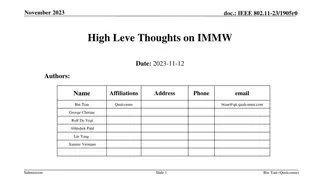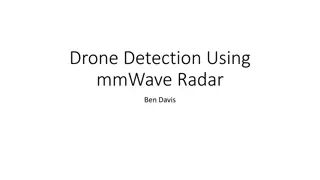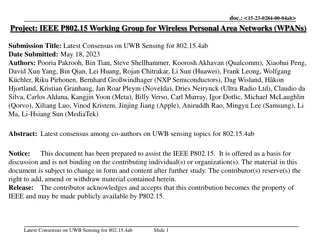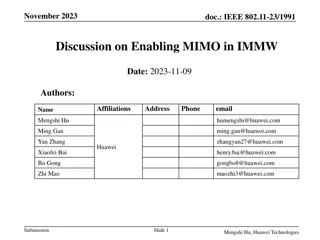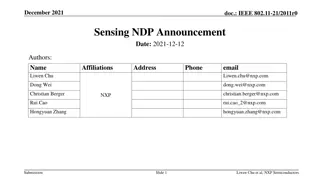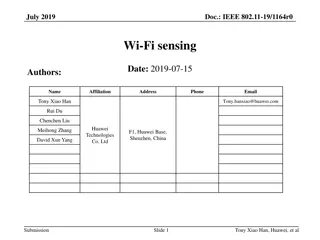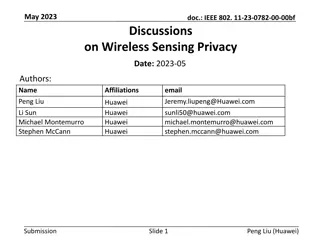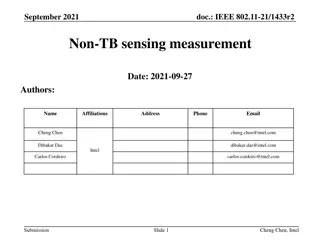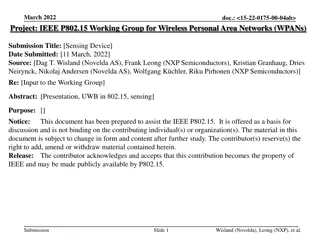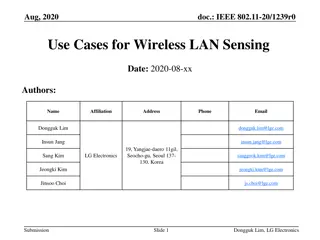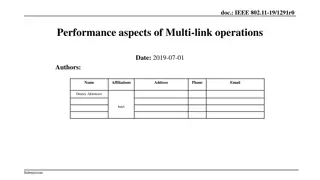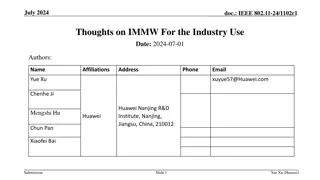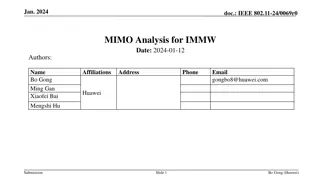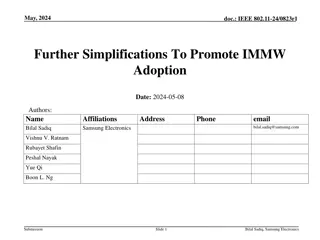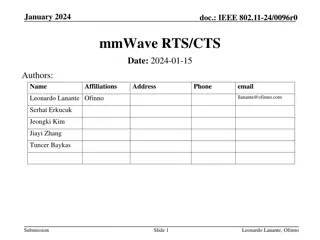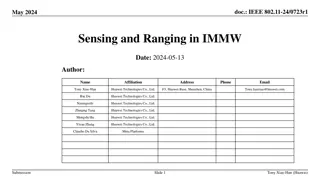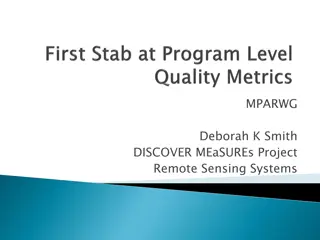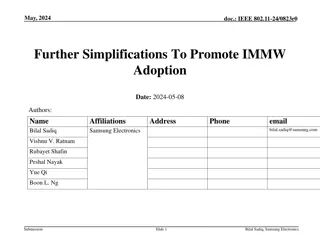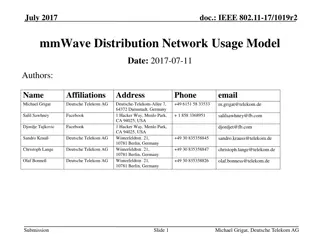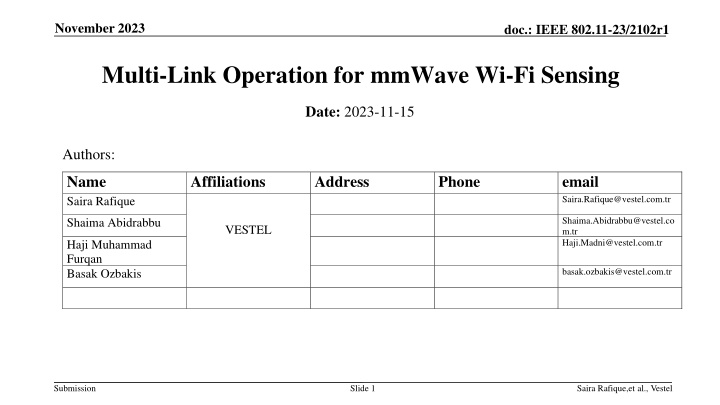
Leveraging Multi-Link Operation for mmWave Wi-Fi Sensing in IEEE 802.11-23
Explore the innovative multi-link operation approach proposed for IEEE 802.11-23 to enhance throughput, coverage, and latency in mmWave Wi-Fi sensing. Leveraging the integration of mmWave and sub-7 GHz bands, this advancement aims to revolutionize Wi-Fi positioning and localization systems for improved user experiences.
Download Presentation

Please find below an Image/Link to download the presentation.
The content on the website is provided AS IS for your information and personal use only. It may not be sold, licensed, or shared on other websites without obtaining consent from the author. If you encounter any issues during the download, it is possible that the publisher has removed the file from their server.
You are allowed to download the files provided on this website for personal or commercial use, subject to the condition that they are used lawfully. All files are the property of their respective owners.
The content on the website is provided AS IS for your information and personal use only. It may not be sold, licensed, or shared on other websites without obtaining consent from the author.
E N D
Presentation Transcript
November 2023 doc.: IEEE 802.11-23/2102r1 Multi-Link Operation for mmWave Wi-Fi Sensing Date: 2023-11-15 Authors: Name Saira Rafique Affiliations Address Phone email Saira.Rafique@vestel.com.tr Shaima.Abidrabbu@vestel.co m.tr Haji.Madni@vestel.com.tr Shaima Abidrabbu VESTEL Haji Muhammad Furqan Basak Ozbakis basak.ozbakis@vestel.com.tr Submission Slide 1 Saira Rafique,et al., Vestel
November 2023 doc.: IEEE 802.11-23/2102r1 Introduction IMMW SG focuses on leveraging MAC/PHY specifications in the Sub 7 GHz band for the carrier frequency operation between 42.5 and 71 GHz [1], [2]. The new MAC/PHY amendment should provide the opportunity for [3], [4]: Enhanced throughput Increased coverage Low Latency Integrated mmwave and Sub-7 GHz band The increased bandwidth because of mmwave and Sub-7 GHz integration can be leveraged to improve sensing in addition to enhanced throughput. Submission Slide 2 Saira Rafique,et al., Vestel
November 2023 doc.: IEEE 802.11-23/2102r1 Multi-Link Operation The aggregated throughput and sensing resolution enhancement at both APs and STAs is achieved through multi-link operation [4]. Throughput and sensing resolution enhancement require increment in the frequency spectrum. The bandwidth of 6 GHz band cannot be extended due to limited availability of wider bandwidth channels. The recommended minimum bandwidth that aligns with the sub 7-GHz PHY is 80 MHz. A wider bandwidth of 1 GHz is available for high-end devices. Submission Slide 3 Saira Rafique,et al., Vestel
November 2023 doc.: IEEE 802.11-23/2102r1 Characteristics of mmWave Band Short transmission range. High throughput/ high-resolution sensing. LOS dominant links. Submission Slide 4 Saira Rafique,et al., Vestel
November 2023 doc.: IEEE 802.11-23/2102r1 WiFi Positioning WiFi positioning system requires multiple APs for accurate and reliable position estimation. Triangulation is used to locate an object where multiple APs increase the effective bandwidth for localization [5]. The location of the participating APs is known. The integrated mmWave band and its additional bandwidth can be leveraged to locate nearby users without multiple devices. Submission Slide 5 Saira Rafique,et al., Vestel
November 2023 doc.: IEEE 802.11-23/2102r1 Proposed Approach We are exploiting multi-bands-based Wi-Fi networks for localization. Location of the nearby users/STAs can be estimated using the mmwave band. Because of small coverage it is not able to provide coverage to the farthest users/STAs. Since mmwave band provides larger bandwidth and improved range resolution, fewer number of devices are sufficient to locate a nearby user/STA and triangulation can be avoided. However, due to limited coverage farther users/STAs get access via sub-7 GHz band and triangulation is required to localize them due to limited bandwidth. Submission Slide 6 Saira Rafique,et al., Vestel
November 2023 doc.: IEEE 802.11-23/2102r1 System Model 1 for Proposed Approach In this scenario, the location of WiFi APs is fixed. Each AP is equipped with multiple bands. STA1 is located near to the APs. STA2 is farther, i.e. outside the room. Location of the nearby STAs can be estimated using the mmWave band without employing triangulation. Since mmWave band is restricted in coverage, the farthest STAs can be localized using conventional triangulation approach. Submission Slide 7 Saira Rafique,et al., Vestel
November 2023 doc.: IEEE 802.11-23/2102r1 System Model 2 for Proposed Approach In the second system model, the APs are relocated based on the position of STAs. Only one AP is used for localizing indoor STAs, hence rest of the two APs which were participating in the triangulation procedure are moved outside coverage region 1. Within coverage region 1, mmWave band is used for localization. Rest of the two APs are moved to coverage region 2 for coverage enhancement and localizing STA 4. Submission Slide 8 Saira Rafique,et al., Vestel
November 2023 doc.: IEEE 802.11-23/2102r1 Target Considerations for the Proposed Approach 1. 2. 3. 4. 5. 6. 7. Optimizing the number of APs. Increasing the coverage. Improving sensing. User location-based clustering. Exploiting Multi-link operation. Reduce the number of APs for localization exploiting MLO. Optimizing the AP location based on user location for coverage enhancement. Submission Slide 9 Saira Rafique,et al., Vestel
November 2023 doc.: IEEE 802.11-23/2102r1 Conclusions A new approach for sensing based on a Wi-Fi network is suggested where two scenarios are presented by exploiting MLO. Based on the proposed approach, the range/coverage could be further enhanced with an efficient number of APs being used. Submission Slide 10 Saira Rafique,et al., Vestel
November 2023 doc.: IEEE 802.11-23/2102r1 References [1] 23/0481r2, Integrated mmWave Study Group Creation , March 2023. [2] 23/0188r6, 802.11 March 2023 WG Motions , March 2023. [3] 22/0030r1, Look ahead to next generation , January 2022. [4] 22/1083r1, Next generation SG formation , July 2022. [5] C. Yang and H. -r. Shao, "WiFi-based indoor positioning", in IEEE Communications Magazine, vol. 53, no. 3, pp. 150-157, March 2015. Submission Slide 11 Saira Rafique,et al., Vestel

